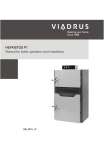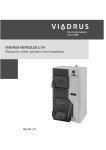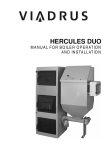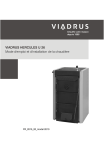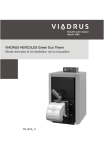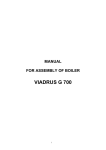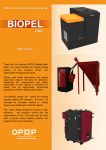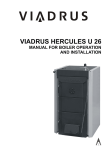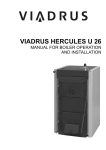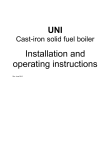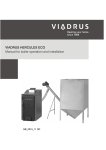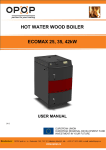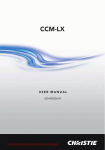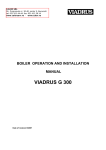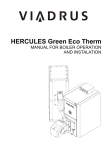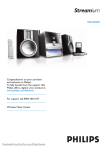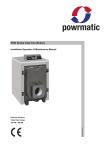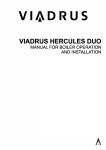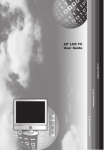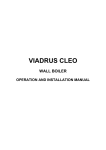Download Viadrus Hercules P 1 Technical data
Transcript
VIADRUS HERCULES U 22 P/N Manual for boiler operation and installation GB_2014_36 Table of contents: page 1. Manufactured boiler variants......................................................................................................................3 2. Boiler use and advantages ........................................................................................................................3 3. Technical data of boilers ............................................................................................................................4 4. Description .................................................................................................................................................5 4.1 Boiler construction ..............................................................................................................................5 4.2 Control, safety and regulation elements .............................................................................................7 4.3 Boilers wiring diagrams ......................................................................................................................7 5. Positioning and installation ........................................................................................................................9 5.1 Regulations and quidelines ................................................................................................................9 5.2 Positioning possibilities ................................................................................................................... 10 6. Delivery and assembly ............................................................................................................................ 12 6.1 Delivery and accessories ................................................................................................................ 12 6.2 Assembly procedure ........................................................................................................................ 13 7. Commissioning........................................................................................................................................ 16 7.1 Verification before commissioning................................................................................................... 16 7.2 Boilers commissioning ..................................................................................................................... 16 7.3 Boiler conversion from “gaseous or liquid fuels“ to the „solid fuels“ and vice versa ....................... 16 8. Boiler operation by the user .................................................................................................................... 17 9. Maintenance............................................................................................................................................ 18 10. Defects and their elimination ............................................................................................................... 18 11. IMPORTANT WARNINGS ................................................................................................................... 19 12. Instructions for product disposal after its service life ........................................................................... 20 13. Guarantee and liability for defects ....................................................................................................... 20 2 Dear customer, We thank you that you have bought the VIADRUS HERCULES U 22 universal boiler thus having shown your confidence in VIADRUS a.s. For you to get used to a correct way of handling your new product from the beginning please read at first this manual for its usage (first of all the chapter no. 8 – Boiler operation by user, chapter no. 9 – Maintenance and chapter no. 11 – Important warnings). Please follow the undermentioned information and especially those regarding the prescribed annual controls to be done by an authorized specialised firm, whereby a long-time and trouble-free boiler operation will be guaranteed to both your and our satisfaction. 1. Manufactured boiler variants VIADRUS HERCULES U 22 boiler is a universal cast-iron sectional low-pressure boiler designated for combustion of: - Gaseous fuels (natural gas) and its brand name is VIADRUS HERCULES U 22 P - Liquid fuels (fuel oil extra light – TOEL) and its brand name is VIADRUS HERCULES U 22 N In the purchase order you must specify the following data: Purchase order specification code VIADRUS HERCULES U 22 X X Fuel: P: gas N: oil 2. Number of sections: 3: 3 sectional design 4: 4 sectional design 5: 5 sectional design 6: 6 sectional design 7: 7 sectional design 8: 8 sectional design 9: 9 sectional design 0: 10 sectional design Boiler use and advantages The boiler design you have received is designated for combustion of gaseous fuels and its brand name is VIADRUS HERCULES U 22 P and for combustion of liquids fuels and its brand name is VIADRUS HERCULES U 22 N. The three-sectional size is suitable for heat sources reconstruction in smaller houses and leisure amenities. Bigger sizes comply with demands on heating the houses, shops, schools etc. The boiler is only made as a warm-water unit with natural and forced heating water circulation and working overpressure up to 400 kPa (4 bar). Before despatch the boiler is tested for tightness by applying 800 kPa (8 bar) test pressure; it stands the insulation and contact resistance tests. Boiler advantages: 1. A long service life of cast-iron exchanger and all other parts with regard to the quality of used materials. 2. Efficiency of gas combustion 89 %. 3. The reliability of regulation and security elements. 4. Simple operation and maintenance. 5. Low demand on chimney draught.. 6. Graduation of output by the number of sections. 7. Possibility to convert the solid fuels boiler to gaseous or liquid fuels boilers or vice-versa. 3 3. Technical data of boilers Tab. no. 1 Dimensions, technical parameters and electric values of boiler Fuel efficiency: natural gas 33,99 MJ/kg fuel oil extra light (TOEL) 42,7 MJ/kg Number of sections Weight Water space volume Diameter of smoke socket Boiler dimensions: - height incl. OS 03 x width - depth L Volume: - of combustion chamber - of fume ducts Combustion gas volume Water working overpressure Water test overpressure pc kg l mm mm mm 3 m 3 m 3 m kPa (bar) kPa (bar) - 3 218 31,5 4 252 36,2 5 282 40,9 434 0,037 0,028 0,065 530 0,046 0,063 0,109 626 0,058 0,08 0,138 6 312 45,6 7 8 347 377 50,3 55,0 156 1008 x 520 722 818 914 0,069 0,080 0,092 0,097 0,114 0,131 0,166 0,194 0,223 400 (4) 800 (8) see.Fig.. no. 1 9 417 59,7 10 448 64,4 1010 0,104 0,148 0,252 1106 0,115 0,165 0,280 Pressure loss Recommended heating water operating °C 60 – 80 temperature Noise level dB Does not exceed the level 65 dB (A) Chimney draught mbar Min. 0,05 Tensile loss mbar 0,17 0,21 0,24 0,28 0,31 0,36 0,39 Overpressure in the combustion chamber mbar 0,01 0,03 0,05 0,08 0,11 0,14 0,17 Boiler connections – heating water DN 50 – return water DN 50 Connecting voltage 1/N/PE 230 V AC 50 Hz TN - S Electric input kW Max. 0,1 Electric coverage IP 40 Environment basic AA5/AB5 ČSN 33 2000-1 ed. 2 The values independent on the type of used central burner are shown in burner documentation. 0,43 0,2 Tab. no. 2 Thermal-technical parameters of boiler designated for natural gas combustion -3 (Fuel efficiency 33,99 MJ.m , air temperature 15 °C and bar. air pressure 1013,25 mbar) Number of sections Appliance category Output Input Standby loss Efficiency Combustion products weight 9,5% CO2 Combustion products temperature Fuel connecting overpressure pc 3 4 5 6 7 8 9 10 40,7 46,5 0,36 46,5 52,8 0,39 52,3 59,4 0,42 58,1 66 0,44 88,2 99,2 110 I 2H kW kW kW % -1 kg.hod °C mbar 17,7 20.11 0,23 23,3 26.5 0,26 29,1 33 0,30 33,5 44,1 55,2 34,9 39,6 0,33 89 66,1 77,2 Max. 240 18 Tab. no. 3 Thermal-technical parameters of boiler designated for combustion of fuel oil extra light (TOEL) -1 (Fuel efficiency 42,7 MJ.kg , air temperature 15 °C and bar. air pressure 1013,25 mbar) Number of sections Output Input Standby loss Efficiency Combustion products weight 13% CO2 Combustion products temperature Fuel connecting overpressure pc kW kW kW % -1 kg.hod °C mbar 3 17,7 19.9 0,23 4 23,3 26.1 0,26 5 29,1 32,7 0,30 6 34,9 39,2 0,33 7 40,7 45,7 0,36 8 46,5 52,2 0,39 9 52,3 58,8 0,42 10 58,1 65,3 0,44 89 59,6 69,4 79,3 89,3 99,2 Max. 240 According to the boiler manufacturer ´s recommendation 30,2 4 39,6 49,7 300 250 Pa Pressure loss 200 150 100 50 0 15 20 25 30 35 Fig. no. 1 Number of sections L (mm) 3 434 Fig. no. 2 4. Description 4.1 Boiler construction 4 530 40 45 50 6 722 60 Output in kW Pressure loss 5 626 55 7 818 8 914 9 1010 10 1106 Boiler main dimensions The main part of boiler is the cast-iron sectional boiler drum made of grey cast iron according to ČSN 42 2415 or ČSN 42 2420. The pressure parts of the boiler correspond to the strength requirements according to EN 297, EN 303-1, EN 303-2. VIADRUS HERCULES U 22 boiler has a cast-iron closed overpressure combustion chamber. This is a boiler with three draughts. The boiler drum is assembled of sections by means of forced on insertions and tightened with the anchor bolts. The sections create the combustion space, the water space and the convective part. Heating water input and output are situated in the rear part of boiler. The rear section of boiler in its upper part has a smoke extension and a heating water flange, in the lower part a return water flange with a mouthpiece for draining and filling taps. To the front section there are mounted closing plates serving for an easy boiler maintenance. The lower closing plate is prepared for the pressure burner assembly. For a better utilization of heat contained in combustion products there is installed a partition separating the combustion products flow in the boiler drum. In the rear part of boiler there is placed a fireclay shaped piece for protection of boiler drum against unwanted thermal effects. In case of 7-10 sectional version there are used two kinds of central sections: in the front part of the boiler the sections are without the strip, in the rear part of boiler they are with the strip. The strip closes the combustion chamber and returns the flame and combustion products from the rear space into the front part it means through a return way in smoke draughts the combustion products temperature is perfectly utilized. Numbers of sections without a strip and with a strip are shown in table as follows: 5 Tab. no. 4 Central sections of boilers Boiler size in number of sections 2 Central section with a strip Central section without a strip - 1. 2. 3. 4. 5. 6. 7. 8. 9. 10. 3 1 - 4 2 - Boiler drum Rear Fire-clay shaped piece Combustion section partition Fire-clay fillet 166 Combustion space partition right Combustion space partition left Closing plate - upper Closing plate –lower Smoke extension Sealing 11. 12. 13. 14. 15. 16. 17. 18. 19. 20. 5 3 - 6 4 - 7 4 1 8 5 1 9 5 2 10 6 2 Heating water flange Return water flange Filling and draining tap Well G ½“ Check valve for the manometer Boiler shell with insulation Closing lid Plug Clip MEOS Control box OS 03 Fig. No. 3 Diagram of boilers In the upper part of the rear section there is installed a clack-valve of thermo-manometer and a reservoir for thermostat and thermometer sensors. In the lower part of smoke extension there is installed a cleaning cover. The explosive flap belongs to the lower closing plate. The burner connection to fuel supply and refilling is done according to the instructions stated in burner documentation. The whole boiler drum is insulated with health harmless insulation which reduces losses related to heat transfer into environment. 6 The boiler steel shell surface is painted by using a good quality coloured comaxite paint. Tab. no. 5 Combustion space partitions number of sections 3 Combustion section partition Tab. no. 6 Fire-clay lining number of sections Rear Fire-clay shaped piece Fire-clay shaped piece of covering plate Fire-clay fillet 160 x 123 x 20 Fire-clay fillet 83 x 12 x 20 Fire-clay fillet 250 x 123 x 20 4.2 4 1 5 1 6 2 7 2 8 3 9 3 10 3 3 1 1 4 1 1 5 1 1 6 1 1 7 1 1 8 1 1 9 1 1 10 1 1 - 2 - 2 - 2 2 2 2 2 4 2 4 Control, safety and regulation elements All regulation and safety elements are situated in OS 03 control electric box. The thermomanometer, a compound gauge serves for outlet water temperature and water pressure in system determination, the thermostat serves for setting the heating water outlet temperature, the main switch serves for switching on the boiler to get started. The burner defect is signalled by lighting up the LED called “burner fault”. Boiler overheating above the safe limit 90 °C is signalled by lighting up the LED called „overheated“ a at the same time the safety thermostat is blocked (if the boiler burner switches off). 4.3 Boilers wiring diagrams ϑ ϑ ϑ LEGEND: S1 MAIN SWITCH H1 „ON“ SIGNALLING Z1 SUPPRESSION COMPONENT BT1 SAFETY THERMOSTAT H2 BT1 SIGNALLING BT2 SERVICE THERMOSTAT BT4 ROOM THERMOSTAT (BOILER OUTSIDE CONTROL) H3 BURNER DEFECT SIGNALLING X1 TERMINAL BOARD X10 BOILER CONNECTOR Fig.no. 4 Elementary wiring diagram of with OS 03 box 7 (OUTSIDE CONTROL) OUTSIDE CONTROL (OUTSIDE CONTROL) ϑ ϑ BOX LEGEND: S1 MAIN SWITCH H1 „ON“ SIGNALLING Z1 SUPPRESSION COMPONENT BT1 SAFETY THERMOSTAT H2 BT1 SIGNALLING BT2 SERVICE THERMOSTAT BT4 ROOM THERMOSTAT (BOILER OUTSIDE CONTROL) H3 BURNER DEFECT SIGNALLING X1 TERMINAL BOARD X10 BOILER CONNECTOR Fig.no. 5 Elementary wiring diagram of with OS 03 boxes 8 5. Positioning and installation 5.1 Regulations and quidelines Boiler can only be installed by a firm holding a valid license for gas appliances installation and maintenance. A project according to the valid regulations must be prepared for installation. The heating system must be filled with water, that meets the ČSN 07 7401 requirements, especially its harness must not exceed the required parameters. Hardness 2+ Ca Concentration of total Fe + Mn Recommended values mmol/l mmol/l mg/l 1 0,3 (0,3)* *) recommended value WARNING!!! The use of anti-freeze mixture is not recommended by the manufacturer. a) to the heating system ČSN 06 0310 ČSN 06 0830 ČSN 07 7401 EN 267 EN 303-1 EN 303-2 EN 303-3 EN 676+A2 b) to the chimney ČSN 73 4201 Heating systems in buildings – Designing and installation Heating systems in buildings – protecting device Water and steam for thermal energy equipments with working pressure up to 8 MPa. Forced draught oil burners – Definitions, requirements, testing, marking. Heating boilers - Part 1: Heating boilers with forced draught burners Terminology, general requirements, testing and marking Heating boilers - Part 2: Heating boilers with forced draught burners - Special requirements for boilers with atomizing oil burners. Heating boilers - Part 3: Gas-fired central heating boilers - Assembly comprising a boiler body and a forced draught burner Automatic forced draught burners for gaseous fuels. Chimneys and flue gas ducting– designing, implementation and connection of fuel consumers. The connection must carried out only if approved by a chimney organization wand must meet all provisions of these standards. The chimney must be resistant to combustion gases condensate, otherwise it might be seriously damaged. c) regarding the fire regulations ČSN 06 1008 Fire safety of heat installations. EN 13501-1 +A1 Fire classification of construction products and building elements – Part 1: Classification using test data from reaction to fire tests d) to the system of HWS heating ČSN 06 0320 Heating systems in buildings – Hot water preparation – Designing and planning ČSN 06 0830 Heating systems in buildings – Safety devices. ČSN 75 5409 Water installations inside buildings. e) regarding the electric network CSN 33 0165 Electrical regulations. Identification of conductors by colours or numerals. Procedure provisions ČSN 33 1500 Electrical regulations; revision of electrical equipments ČSN 33 2000-1 ed. 2 Low-voltage electrical installations – Part 1: Fundamental principles, assessment of general characteristics, definitions. ČSN 33 2000-4-41 ed. 2 Low voltage electrical installations - Part 4- 41: Protection for safety - Protection against electric shock ČSN 33 2000-5-51 ed. 3 Electrical installations of buildings – Part 5-51: Selection and erection of electrical equipment – Common rules ČSN 33 2130 ed. 2 Low-voltage electrical installations – Internal electric distribution lines ČSN 33 2180 Electrical regulations: Connection of electric instruments and appliances ČSN 34 0350 ed. 2 Safety requirements for flexibile cords and cables EN 60079-10-1 Explosive atmospheres — Part 10-1: Classification of areas — Explosive gas atmospheres EN 60079-14 ed.3 Explosive atmospheres - Part 14: Electrical installations design, selection and erection EN 60252-1 ed. 2 Capacitors for AC motors – Part 1: In general – Design, testing, dimensioning – Safety requirements – Instructions for installation and operation. 9 EN 60 335-1 ed.2 EN 60 335-2-102 EN 60445 ed. 4 Electric appliances for household and similar purposes – Safety – Part 1: General requirements Electric appliances for household and similar purposes – Safety – Part 2-102: Special demands on appliances containing the electric connections and burning the gas, oil and solid fuels Basic and safety principles for man-machine interface, marking and identification – Identification of equipment terminals, conductor terminations and conductors f) to the gas distribution EN 1775 Gas supply. Gas pipework for buildings. Maximum operating pressure less than or equal to 5 bar. Functional recommendations EN 12007-1 Gas supply systems - Pipelines for maximum operating pressure up to and including 16 bar - Part 1: General functional recommendations EN 12007-2 Gas supply systems - Pipelines for maximum operating pressure up to and including 16 bar - Part 2: Specific functional recommendations for polyethylene (MOP up to and including 10 bar) EN 12007-3 Pipelines for maximum operating pressure up to and including 16 bar - Part 3: Specific functional recommendations for steel EN 12007-4 Gas supply systems - Pipelines for maximum operating pressure up to and including 16 bar - Part 4: Specific functional recommendations for renovation ČSN 38 6405 Gas equipments. Operating principles Act No. 458/2000 Coll. on Business Conditions and Public Administration in the Energy Sectors and on amending certain acts (the Energy Act) Promulgation 91/93 Coll. of Czech work safety office regarding the work safety assurance in low-pressure buildings g) to liquid fuel distribution ČSN 65 0201 Combustible liquids. Premises for production, storage and handling Act no. 133/85 Coll. Act of The Czech National Council on Fire Protection Act no. 254/2001 Coll. on Waters and Amendments to some acts (the Water Act). h) oil storage ČSN 65 0201 ČSN 65 7991 ČSN 73 0081 ČSN 75 3415 Combustible liquids. Premises for production, storage and handling Oil industry products. Fuel oils. Technical requirements. Corrosion protection in building industry. Water protection against oil products. Facilities for handling the oil products and their storage. Based on the regulation issued by Czech Office for Labour Protection– Code no. 91/1993 it is necessary to distinguish in design, erection, positioning and operation of low-pressure steam-boiler rooms: - boilers with rated heat output up to do 50 kW - boilers with rated heat output up 50 kW and above – boiler room category III – it regards boiler VIADRUS HERCULES U 22 P in 9 and 10 sectional design. ČSN 07 0703 Boiler room with gas fuel –operated equipments ČSN 38 6420 Industrial gas pipelines 5.2 Positioning possibilities Boiler positioning in the living space (including corridors) is prohibited! The boiler is equipped with a movable mains supply and a plug. The boiler must be according to EN 60 335 – 1 ed. 2 Art. 7.12.4 positioned in a way making sure that the plug is accessible. The installation of the boiler must comply with all requirements of ČSN 06 1008. Boilers positioning with regard to the fire regulations: 1. Positioning on the floor made of incombustible material (Fig. No.6) The boiler can be installed on a fireproof thermally insulating bottom exceeding the boiler platform by 20 mm on the sides and only up to the boiler drum depth. If the boiler is positioned in a cellar we recommend to install it on a retaining wall (bedding) minimum 50 mm high 2. A safe distance from the combustible materials when installing and operating the boiler it is necessary to keep a safety distance of 200 mm from the materials of combustibility grade A1, A2, B and C (D); 10 - - for easily combustible materials of combustibility grade E (F), which quickly burn and burn themselves even after removal of ignition source (such as paper, cardboard, asphalt and tar paper, wood and wood-fiber boards, plastics, floor coverings) the safe distance has to be doubled, i.e. to 400 mm; safe distance should be doubled as bulb where the grade of reaction to fire has not been proved. Number of sections L (mm) 3 4 5 6 7 8 9 420 515 610 705 800 895 990 Fig.no. 6 10 1085 Retaining wall (bedding)depth Tab. no. 7 Grade of reaction to fire Examples of building materials and products included in the reaction to fire (Extract from EN 13501-1 + A1) A1 – incombustible Granite, sandstone, concrete, bricks, ceramic tiles, mortars, fireproof plasters, … A2 – combustible with difficulty acumin, izumin, heraklit, lignos, boards and basalt felt, fibreglass boards,... B – hardly combustible Beech and oak wood, hobrex boards, plywood, werzalit, umakart, sirkolit,... C (D) – medium combustible Pinewood, larch, whitewood, chipboard and cork boards, rubber flooring,... Asphaltboard, fibreboards, cellulose materials, polyurethane, polystyrene, E (F) – easily combustible polyethylene, PVC,… Grade of reaction to fire Number of sections L (mm) Fig. no. 7 3 434 4 530 5 626 6 722 7 818 8 914 9 1010 Boiler positioning in boiler room 11 10 1106 Boilers positioning with regard to the necessary handling space: − − − − − − Basic AA5/AB5 according to ČSN 33 2000-1 ed. 2 In front of the boiler there must be left a minimum 1000 mm handling area minimum 400 mm distance between the rear part of boiler and the wall at least from one lateral face keep minimum 400 mm space for access to the boiler rear part minimum 100 mm distance from the lateral face the boiler is connected to the el. network 230 V/50 Hz through a cable with a plug to a normalized socket secured 10 A − the connecting socket must within operators ´ easy reach or the boiler must be connected through the main switch within operators ´ easy reach 6. Delivery and assembly 6.1 Delivery and accessories Standard accessories to the boiler: • • • • • • • • • • • • • • • • • • Cleaning tools (brush with a handle) Completely equipped operating box OS 03 Filling and draining tap Js 1/2“ Plug Js 6/4“ blind Heating water flange DN 50 Return water flange DN 50 with a mouthpiece 1/2“ Well of thermostat Elbow Js 1/2“ for filling and a drain tap Sealing φ 85 x 60 x 3 Set of fire-clay lining Clip MEOS Shell coupling pins Nut M10 Washer 10,5 Plug Sheet-metal screws ST 4,8 x 13 Closing lid Commercial & technical documentation 1 pc 1 pc 1 pc 2 pcst 1 pc 1 pc 1 pc 1 pc 2 pcs 4 pcs 4 pcs 8 pcs 10 pcs 4 pcs 4 pcs 1 pc Tab. no. 8 Burners at VIADRUS HERCULES U 22 P designated for natural gas combustion Number of sections 3 4 5 6 7 8 9 10 Output kW 17,7 23,3 29,1 34,9 40,7 46,5 52,3 58,1 Bentone BG 100 Bentone BG 200 L Burner Tab. no. 9 Burners at VIADRUS HERCULES U 22 N designated for fuel oil extra light combustion (TOEL) Number of sections 3 4 5 6 7 8 9 10 Output kW 17,7 23,3 29,1 34,9 40,7 46,5 52,3 58,1 Bentone B 10 Bentone B 20 Burner Optional accessories to boiler: • • heating water threaded flange Js 6/4“ (1 pc) return water threaded flange Js 6/4" with a mouthpiece for filling and drain tap Optional boiler equipment isn’t included in the boiler basic price (standard design). 12 6.2 Assembly procedure Boiler drum installation 1. Set the boiler drum on the bedding. 2. Set the sealing φ 86 x 60 x 3 on the upper flanged part of boiler rear section and attach the heating water flange. Prior to that weld the flange to the heating water distribution system 3. Set the sealing φ 86 x 60 x 3 on the lower flanged part of boiler rear section and attach the return water flange with a mouthpiece for filling and drain tap. Prior to that weld the flange to the return water distribution system 4. After the boiler has been connected to the heating system screw an elbow and filling and drain taps into the do mouthpiece. 5. Screw the well of thermostat into the hole in the top part of the rear section. 1 2 Check valve for the manometer Well of thermostat 6. Set the stove-pipe on the smoke extension and insert into the chimney opening. 7. Two openings with threads Js 6/4" in the front section blind with plugs Js 6/4" 8. Remove the upper and lower closing plate 9. Insert the fireclay lining and combustion chamber partition. 10. The fireclay parts layout is shown in Fig. no. 3, and in tab. no. 5 and no. 6 there is stated a breakdown of used fireclay blocks, fillets and cast-iron plates that make up the combustion space partition. - Put the rear fireclay block to the rear boiler wall - Put longitudinally the fireclays fillets on the grates according to the breakdown see table tab. no. 6 - On the risers in the upper part of combustion chamber put the cast-iron plates forming the combustion chamber partition. The gap for combustion products outlet must be kept in the rear part of boiler in order to achieve the correct combustion products flow. - It is necessary to watch a correct way of seating the front part of the combustion chamber partition to the front section up to the stop. 11. Reassemble the upper and lower closing plates 12. Install the burner according to the manual for its installation 13 Shells assembly 1. Take out the shells from cardboard cover. 2. According to Fig. no. 8 mount the delivered joining material into the side parts of the shell and fasten the consoles. 3. Loosen the lower anchorage screws, set on the side boiler shell consoles. Insert the front consoles between the washers with nuts and the front section body, insert the rear consoles directly on anchor bolts. By lifting put the boiler shell bearing edges behind the upper anchorage bolts. Tighten the lower anchor bolts nuts. 4. Remove the insulation from the upper part of boiler shell. From OS 03 control box dismount the screws for the box shell attachment. Remove the sensors of safety thermostat, thermomanometer and the boiler thermostat. Screw the bottom of the box to the prepared cut-in in the rear part of shell upper part a pull the sensors through it. Through the bushings in the side edges pull through the control cables and secure them with MEOS clips. Pull the cables through the cut-in into jacketed control box and connect to the terminal board according to boiler el. wiring diagram (see. Fig. no. 4 and 5). 5. Insert the rear part of the shell with insulation behind the sheet-metal screws. Pull the conductors from inside through the upper part of the shell. Set the upper part of shell with insulation on the plugs of shell side parts; here it is necessary to insert the sensors of thermostats and thermometer in the reservoir for thermostat and thermometer and screw the manometer sensor into the reservoir for manometer. 6. The closing lid must be set into the prepared opening in the front part of the shell upper part. 7. Set and secure the upper part of OS 03 control box. 8. Screw the brush into the handle sleeve. 9. Filling the heating system with water. Water for boilers and heating system filling must be clear and colourless, with no suspended materials, oil and aggressive chemicals. Its hardness must correspond to ČSN 07 7401 and it is necessary to treat water in case its hardness is unsuitable. Even heating the water with a higher hardness several times does not prevent the soils from getting precipitated on the boiler drum walls. Precipitation of 1 mm calcite reduces at given point the passage of heat from the metal to water by 10 %. The heating systems with an open expansion reservoir allow a direct contact between heating water and atmosphere. During the heating season the expanding water in reservoir absorbs oxygen which increases the corrosive affects and at the same lot of water gets evaporated. It can only be replenished by water treated according to ČSN 07 7401. The heating system must be thoroughly flushed in order to wash out all impurities. During the heating season the water volume in heating system must be kept constant. When refilling the heating system with water it is necessary to prevent it from air intake. Water from boilers and heating system must never be discharged or taken for usage except in cases of emergency like repairs etc. Water discharge and filling with new water increases the danger of corrosion and scale development. In case we have to refill the heating system with water we only do this operation when boiler is cold in order to prevent the sections from getting damaged. 10. After having filled a boiler and heating system it is necessary to check all joints for their tightness. The assembly completion and stoking tests accomplishment must be recorded in “Guarantee certificate”. 14 1. 2. 3. 4. 5. 6. Side part of shell (2 pcs) Insulation of shell side part (2 pcs) Pin (4 pcs) Sheet-metal screws ST 4,8 x 13 (4 pcs) Insulation of shell back part (1 pc) Back part of shell (1 pc) Fig. no. 8 7. 8. 9. 10. 11. 12. Insulation of shell upper part (1 pc) Upper part of shell (1 pc) Clip MEOS (4 pcs) Plug (4 pcs) Closing lid (1 pc) Control box OS 03 (1 pc) Boiler shell assembly 15 7. Commissioning Boiler commissioning, thermal output setting and any interference in electric part of the boiler or connection of other control elements can only be done by a contracting service organization authorized to do the service works. 7.1 Verification before commissioning Before the boiler commissioning it is necessary to check: a) Heating system filling with water (thermo-manometer and system tightness check-up) o b) Boiler thermostat setting to 60 - 80 C c) Fuel input pressure before the boiler (15 – 23 mbar for natural gas, fuel oil extra light (TOEL) according to burner documentation) d) Connection to electric network 230 V/50 Hz via a cable with a plug to a standardized socket secured by 10 A.ČSN 33 2180 Art. 6.2.2. – the sockets is carried out in a way making sure that the protective plug is up and the middle or zero conductor is connected to right hand cup in the front view. The same applies to the double sockets. e) Connection to the chimney. 7.2 Boilers commissioning 1. The installation, burner assembly and its adjustment plus boiler commissioning together with the burner must be done by a burner supplier ´s service firm. The service firm will give the user a training in operating the burner, a manual for burner operation and will provide its guarantee and after guarantee repairs. 2. Gas or fuel oil extra light (TOEL) connection to the burner and the electric network 3. Boiler commissioning– setting the heating water outlet temperature to 80 °C. 4. Operate the boiler in this operating condition according to adequate standards 5. Make the user acquainted with boilers operation 6. Put down a record in the Guarantee certificate. 7.3 Boiler conversion from “gaseous or liquid fuels“ to the „solid fuels“ and vice versa In case that the user according to the situation has decided to convert his boiler from „gaseous or liquid fuels“ to „solid fuels“, he will have this conversion done by a contracting service firm - an organization competent to do this activity which will convert the boiler including the adequate operation test. The manufacturer will deliver the parts for conversion. 16 8. Boiler operation by the user The boiler works automatically according to the regulation elements setting and the user only does following operations that the worker commissioning the boiler is obliged to acquaint him with: 1. Boiler switch on and switch off by means of the network switch on the boiler control panel. 2. Setting and control of required heating water temperature in the range of 0 – 80 °C. We recommend to set this temperature only at the boilers without regulation. If the boiler is controlled by the indoor thermostat or another regulation the boiler thermostat must be in the highest temperature position. 3. If the boiler failure state occurs, the signal lamp signalling the burner fault lights up in the boiler control panel. In case of electricity network outage the burner is switched off and after the network voltage restoration the burner is restarted automatically. 4. Safety thermostat unblocking. If the boiler has been switched off by a safety thermostat the signal lamp signalling “the temperature exceeded” lights up in the control panel. Thermostat can be unblocked by the user by means of "unblocking" button at the safety thermostat positioned at the rear panel of the control box. 5. Pressure control in the heating system 1. 2. 3. 4. 5. 6. 7. Fig. no. 9 OS 03 Control box 17 Control box Termomanometer Service thermostat Safety thermostat Main switch Signal lamp – overheated Signal lamp – burner fault 9. Maintenance All interventions can only be done by contractual service organization trained by the manufacturer. 1. Disconnect the boiler from the electricity supply. 2. Close the fuel supply to burner. 3. Push the burner out from the combustion space. 4. Dismount the closing plates from the boiler drum. 5. Check the clogging of the boiler convection surfaces and clean them chemically (like by Metano Therm). If the regular maintenance was neglected and the convection surfaces are heavily clogged apply the procedure as follows: - fill all convection surfaces vents with diluted soap solution by pouring it from above; - let the solution effect for approx. 10minutes; - use a lower water pressure for spraying the convection surfaces; - repeatedly by applying a higher water pressure complete the convection surfaces cleaning; - remove thoroughly the impurities from the space of burner. 6. Check the burner nozzle clogging. In case of impurities clean it according to burner manufacturer´s instructions. 7. Mount back the closing plates and install the burner. 8. Open the fuel supply, renew the connection to the el. network and start the boiler. 9. Check the tightness of the fuel inlet to the burner. 10. Set and adjust the boiler thermal output. 10. Defects and their elimination The defects can only be eliminated by a trained contractual service organization which notes down the remedy in the guarantee attachment. If the safety thermostat keeps blocking repeatedly also the contractual service worker must be called. 18 11. IMPORTANT WARNINGS 1. The boiler only can be used for the purpose that it is destined for. 2. The boiler can only be operated by adult persons and it is forbidden to leave children at the boiler without being attended by adults. 3. The boiler is not destined for the use by persons (incl. children) whose physical, sensual or mental disability or lack of experience and knowledge prevent them from a safe use of the appliance unless they are supervised or if they were not instructed on the use of appliance by a person responsible for their safety. 4. Children should be supervised in order to ensure that they do not play with the appliance. 5. In case of a long-term still-stand of boilers they must be disconnected from electricity networkfrom the socket. 6. Boiler rooms must be kept clean and dustless. From the boiler room area there must be removed all sources of pollution and during the works (insulating works, boiler room cleaning) which cause the dustiness the boiler must be put out of operation. Even the partial impurities deposits on the burner will degrade the combustion process and threaten an economic and reliable boiler operation. We don’t recommend to keep domestic animals (dogs, cats etc.) in boiler rooms 7. In case that there occurs the danger of flammable vapours or gases penetration into the boiler room or during the works at which there is a temporary fire or explosion danger (gluing the flooring, paints using the flammable materials) the boiler must be long enough before the works put out of operation. 8. Don’t put any objects made of flammable materials on boiler and within a distance smaller than the safe distance from it. 9. It is necessary to install a safety valve for maximum overpressure of 400 kPa (4 bar) on the system and its dimension must correspond to the rated boiler output. The safety valve must be located directly behind the boiler. Any stop valve must not be located between the safety valve and boiler. If you have any questions, please contact our contractual assembly firm and service organizations. 10. The user is obliged to charge with boiler commissioning, its regular maintenance and defects elimination only a professional contractual service accredited by VIADRUS a.s., the boilers manufacturer, otherwise there does not apply the guarantee for boilers proper function. “VIADRUS HERCULES U 22 P and VIADRUS HERCULES U 22 N quality and completeness certificate“ filled in by the service contractual organization serves as the “Guarantee certificate“. 11. Once a year it is necessary to do a regular boiler maintenance according to chapter no. 10. 12. During assembly, installation and operation of the appliance it is necessary to comply with standards that apply in the relevant country of destination. If these conditions are not observed the guarantee repairs cannot be required. 19 12. Instructions for product disposal after its service life VIADRUS a.s., is contractual partner of firm EKO – KOM a.s. with client number F00120649. The packages comply with EN 13427. Because the product is made of common materials its individual components are recommended to be disposed of as follows: - exchanger (grey cast-iron), via a firm dealing with waste collection and disposal - piping, sheathing via a firm dealing with waste collection and disposal - other metal parts via a firm dealing with waste collection and disposal - ROTAFLEX insulation material into common waste We recommend to dispose the packages in the following way: - plastic foil, cardboard cover, use a salvage point - metal strapping tape, use a salvage point - wooden base, is designated for a single usage and no longer can be used as a product. Its disposal is subject to Act. 477/2001 Sb. a 185/2001 Coll.as amended. In case that the product has lost its serviceability you can take advantage of product “take back service” (if this is established); in case that the originator has declared that it is a scrap it must be handled according to the valid legislation of relevant country. 13. Guarantee and liability for defects VIADRUS a.s. provides the guarantee: – For boilers 24 months after the boiler putting into operation, but maximum 30 months after the date it was dispatched from the VIADRUS a.s.; – For boiler drum 5 years after the date its dispatch from the VIADRUS a.s. For possible claim regarding the shell the customer is obliged to submit the boiler shell plate positioned on the cardboard in which the shell is dispatched. The manufacturer requires for the guarantee applicability: – In sense of Act no. 458/2000 Coll. and ČSN 38 6405, EN 1775 to carry out regularly once a year the check of natural gas or fuel oil extra light TOEL boilers. The checks can only be done by an authorized organization (contractual service), accredited by VIADRUS a.s. – In case of 9 and 10 sectional boilers it is necessary to observe the conditions set by Collection of Laws no. 91/1993 and ČSN 07 0703, ČSN 38 6420. – To document all records about the carried out guarantee and after-guarantee repairs and regular annual checkups in the annex enclosed to this manual guarantee certificate. Every defect must be announced immediately after having been detected, always in writing and via an agreement made by telephone. If the above instructions are not observed the manufacturer will not provide his guarantees. The guarantee does not apply to: - faults caused by improper assembly and improper attendance of the product and faults caused by improper maintenance see chap. 9; - faults and damage caused by failure to observe water quality in heating system see chap. no. 5.1 and 6.2 or by using the anti-freeze mixture; - faults caused by failure to observe instructions stated in this manual; - product damage arisen during transport or other mechanical damage; - faults caused by an unsuitable storage (like water); - faults caused by natural disasters or force majeure. The manufacturer reserves the right to make changes within the product innovations that needn’t be included in this manual. 20 Information for customer Packaging identification Assessment reference PE Plastic sacks, folie, corrugated board, iron and plastic fix line Identification of principal materials used. Paper, Polyethylene, iron, wood Part 1: Summary of assessment Standard/Report Assessment requirement 1.1 Prevention by source reduction 1.2 Heavy metals and ensure below maximum permitted levels for components (CR 13695-1) 1.3 Other ensure in compliance with noxious/hazardous (ČSN 77 0150-2, EN 13428) substances 2 Reuse ensure reusability in all terms of the standard for the functional packaging unit (EN 13429) 3.1 Recovery by material ensure recyclability in all terms of the recycling standard for the functional packaging unit (EN 13430) 3.2 Recovery in the form ensure that calorific gain is achievable for of energy the functional packaging unit (EN 13431) 3.3 Recovery by ensure compost ability in all terms of the composting standard for the functional packaging unit (EN 13432) Claim Note YES YES YES NO YES YES Iron - NO NO NOTE Conformity with EN 13427 requires affirmative responses to sections 1.1; 1.2; 1.3 and to at least one of 3.1; 3.2; 3.3. In addition, where a claim of reuse is made section 2 should also record affirmative responses. Part 2: Statement of conformity In the light of the assessment results recorded in part I above, this packaging is claimed to comply with the requirements of EN 13427. 21 22 Annex to the guarantee certificate for customer- the user Record of accomplished guarantee and after-guarantee repairs and regular annual product checks Record date Contracting service organization (stamp, signature) Carried out activity 23 Customer ´s signature VIADRUS HERCULES U 22 P/N VIADRUS a.s. Bezručova 300 | 735 81 Bohumín | CZ telefon: +420 596 083 050 | fax: +420 596 082 822 e-mail: [email protected] | www.viadrus.cz
























